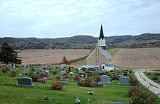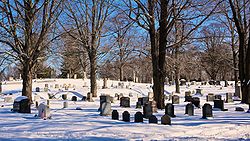
Graveyard
Encyclopedia

Headstone
A headstone, tombstone, or gravestone is a marker, usually stone, that is placed over a grave. In most cases they have the deceased's name, date of birth, and date of death inscribed on them, along with a personal message, or prayer.- Use :...
s. It is usually located near and administered by a church.
Since the mid-19th century, the term cemetery
Cemetery
A cemetery is a place in which dead bodies and cremated remains are buried. The term "cemetery" implies that the land is specifically designated as a burying ground. Cemeteries in the Western world are where the final ceremonies of death are observed...
has become a more popular label for most burying grounds.
Origins and class distinctions
Graveyards were usually established at the same time as the building of the relevant place of worship (which can date back to the 8th to 14th centuries) and were often used by those families who could not afford to be buried inside or beneath the place of worship itself. In most cultures those who were vastly rich, had important professionProfession
A profession is a vocation founded upon specialized educational training, the purpose of which is to supply disinterested counsel and service to others, for a direct and definite compensation, wholly apart from expectation of other business gain....
s, were part of the nobility
Nobility
Nobility is a social class which possesses more acknowledged privileges or eminence than members of most other classes in a society, membership therein typically being hereditary. The privileges associated with nobility may constitute substantial advantages over or relative to non-nobles, or may be...
or were of any other high social status
Social status
In sociology or anthropology, social status is the honor or prestige attached to one's position in society . It may also refer to a rank or position that one holds in a group, for example son or daughter, playmate, pupil, etc....
were usually buried in individual crypt
Crypt
In architecture, a crypt is a stone chamber or vault beneath the floor of a burial vault possibly containing sarcophagi, coffins or relics....
s inside or beneath the relevant place of worship
Place of worship
A place of worship or house of worship is an establishment or her location where a group of people comes to perform acts of religious study, honor, or devotion. The form and function of religious architecture has evolved over thousands of years for both changing beliefs and architectural style...
with an indication of the name of the deceased, date of death and other biographical data. In Europe this was often accompanied with a depiction of their family coat of arms
Coat of arms
A coat of arms is a unique heraldic design on a shield or escutcheon or on a surcoat or tabard used to cover and protect armour and to identify the wearer. Thus the term is often stated as "coat-armour", because it was anciently displayed on the front of a coat of cloth...
.
Most of middle or low social status others were buried in graveyards around the relevant church again divided by social status. Families of the deceased who could afford the work of a stonemason had a headstone
Headstone
A headstone, tombstone, or gravestone is a marker, usually stone, that is placed over a grave. In most cases they have the deceased's name, date of birth, and date of death inscribed on them, along with a personal message, or prayer.- Use :...
carved and set up over the place of burial with an indication of the name of the deceased, date of death and sometimes other biographical data. Usually, the more writing and symbols carved on the headstone, the more expensive it was. As with most other human property such as houses and means of transport, richer families used to compete for the artistic value of their family headstone in comparison to others around it, sometimes adding a statue (such as a weeping angel
Angel
Angels are mythical beings often depicted as messengers of God in the Hebrew and Christian Bibles along with the Quran. The English word angel is derived from the Greek ἄγγελος, a translation of in the Hebrew Bible ; a similar term, ملائكة , is used in the Qur'an...
) on the top of the grave.
Those who could not pay for a headstone at all usually had some religious symbol made from wood on the place of burial such as a Christian cross
Christian cross
The Christian cross, seen as a representation of the instrument of the crucifixion of Jesus Christ, is the best-known religious symbol of Christianity...
; however, this would quickly deteriorate under the rain or snow. Some families hired a blacksmith
Blacksmith
A blacksmith is a person who creates objects from wrought iron or steel by forging the metal; that is, by using tools to hammer, bend, and cut...
and had large crosses made from various metals put on the place of burial.
Graveyards replaced by cemeteries

- A very sharp rise in the size of the population during the early stages of the Industrial RevolutionIndustrial RevolutionThe Industrial Revolution was a period from the 18th to the 19th century where major changes in agriculture, manufacturing, mining, transportation, and technology had a profound effect on the social, economic and cultural conditions of the times...
- Continued outbreaks of highly infectious diseaseInfectious diseaseInfectious diseases, also known as communicable diseases, contagious diseases or transmissible diseases comprise clinically evident illness resulting from the infection, presence and growth of pathogenic biological agents in an individual host organism...
s in towns and cities due to lack of public hygiene. Many graveyards in cities were located on land enclosed within the city walls.
- Limits to, and lack of, space in graveyards for new headstoneHeadstoneA headstone, tombstone, or gravestone is a marker, usually stone, that is placed over a grave. In most cases they have the deceased's name, date of birth, and date of death inscribed on them, along with a personal message, or prayer.- Use :...
s and corpsesCadaverA cadaver is a dead human body.Cadaver may also refer to:* Cadaver tomb, tomb featuring an effigy in the form of a decomposing body* Cadaver , a video game* cadaver A command-line WebDAV client for Unix....
.
As a consequence of these reasons, city authorities, national governments and places of worship all changed their regulations for burials. In many European states, burial in graveyards was outlawed altogether either by royal decrees or government legislation
Legislation
Legislation is law which has been promulgated by a legislature or other governing body, or the process of making it...
.
In some cases, skeleton
Skeleton
The skeleton is the body part that forms the supporting structure of an organism. There are two different skeletal types: the exoskeleton, which is the stable outer shell of an organism, and the endoskeleton, which forms the support structure inside the body.In a figurative sense, skeleton can...
s were exhumed
Exhumed
Exhumed may refer to:*Exhumation*Exhumed , a first-person shooter*Exhumed , a deathgrind band* Exhumed Films, a Philadelphia-based "organization* Exhumed river channel, a ridge of sandstone...
from graveyards and moved into ossuaries or catacombs
Catacombs
Catacombs, human-made subterranean passageways for religious practice. Any chamber used as a burial place can be described as a catacomb, although the word is most commonly associated with the Roman empire...
. A large action of this type occurred in 18th century Paris
Paris
Paris is the capital and largest city in France, situated on the river Seine, in northern France, at the heart of the Île-de-France region...
when human remains were transferred from graveyards all over the city to the Catacombs of Paris
Catacombs of Paris
The Catacombs of Paris or Catacombes de Paris are an underground ossuary in Paris, France. Located south of the former city gate , the ossuary holds the remains of about 6 million people and fills a renovated section of caverns and tunnels that are the remains of Paris' stone mines...
.
However in most places across Europe completely new places of burial were established away from heavily populated areas and outside of old towns and city centers. Many new cemeteries became municipally-owned, and thus independent from churches and their churchyards; however, even these were still segregated by the faith of the deceased to be buried there.
Thus cemeteries (certainly in their modern landscaped or garden cemetery form), rather than graveyards, became the principal place of burial for the deceased and continue to this day.
Burial in graveyards after the 19th century
Even as far as the 20th century, permission was granted to many small towns and villages to continue using their local graveyards for burials. Many of these places had very small populations with few deaths every year, and had a much better record of public hygiene. Therefore they did not require the establishment of a new burial ground.Present status
Thousands of graveyards still stand across the world today and are usually the place where the oldest graves of a community or part of a city can be found.However, many churches, most notably in England
England
England is a country that is part of the United Kingdom. It shares land borders with Scotland to the north and Wales to the west; the Irish Sea is to the north west, the Celtic Sea to the south west, with the North Sea to the east and the English Channel to the south separating it from continental...
, have sold their churchyards in part or in whole, with or without a graveyard still situated on it. Also in many cases in the late 19th century and 20th century, churches were forced to sell large portions of their churchyard in order for a road to be built or expanded. The loss of part (or all) of the churchyard, often also led to the removal and permanent loss of century-old graves and headstones. In some cases the human remains were exhumed and the gravestones transferred.
In other cases, the churches themselves removed the headstones in the graveyards, to recreate a park-like environment on the churchyard or simply to facilitate the seasonal cutting and removal of grass
Grass
Grasses, or more technically graminoids, are monocotyledonous, usually herbaceous plants with narrow leaves growing from the base. They include the "true grasses", of the Poaceae family, as well as the sedges and the rushes . The true grasses include cereals, bamboo and the grasses of lawns ...
or weed
Weed
A weed in a general sense is a plant that is considered by the user of the term to be a nuisance, and normally applied to unwanted plants in human-controlled settings, especially farm fields and gardens, but also lawns, parks, woods, and other areas. More specifically, the term is often used to...
s.
Scottish law prevents the clearance of graveyards, largely on the basis of how the title deeds are sold. In England, a plot is effectively bought on leasehold for 100 years. Graveyards may therefore be resold 100 years after the last burial and cleared of graves. However, in Scotland, titles to the burial plots (there entitled "lairs") are in perpetuity and therefore can never be moved.
Famous graveyards
- ZentralfriedhofZentralfriedhofThe Zentralfriedhof is one of the largest cemeteries in the world, largest by number of interred in Europe and most famous cemetery among Vienna's nearly 50 cemeteries.-Name and location:...
, Vienna (Austria) - Assistens kirkegård, Copenhagen (Denmark)
- Greyfriars KirkyardGreyfriars KirkyardGreyfriars Kirkyard is the graveyard surrounding Greyfriars Kirk in Edinburgh, Scotland. It is located at the southern edge of the Old Town, adjacent to George Heriot's School. Burials have been taking place since the late 16th century, and a number of notable Edinburgh residents are interred at...
- First Parish Cemetery and Historical Site

